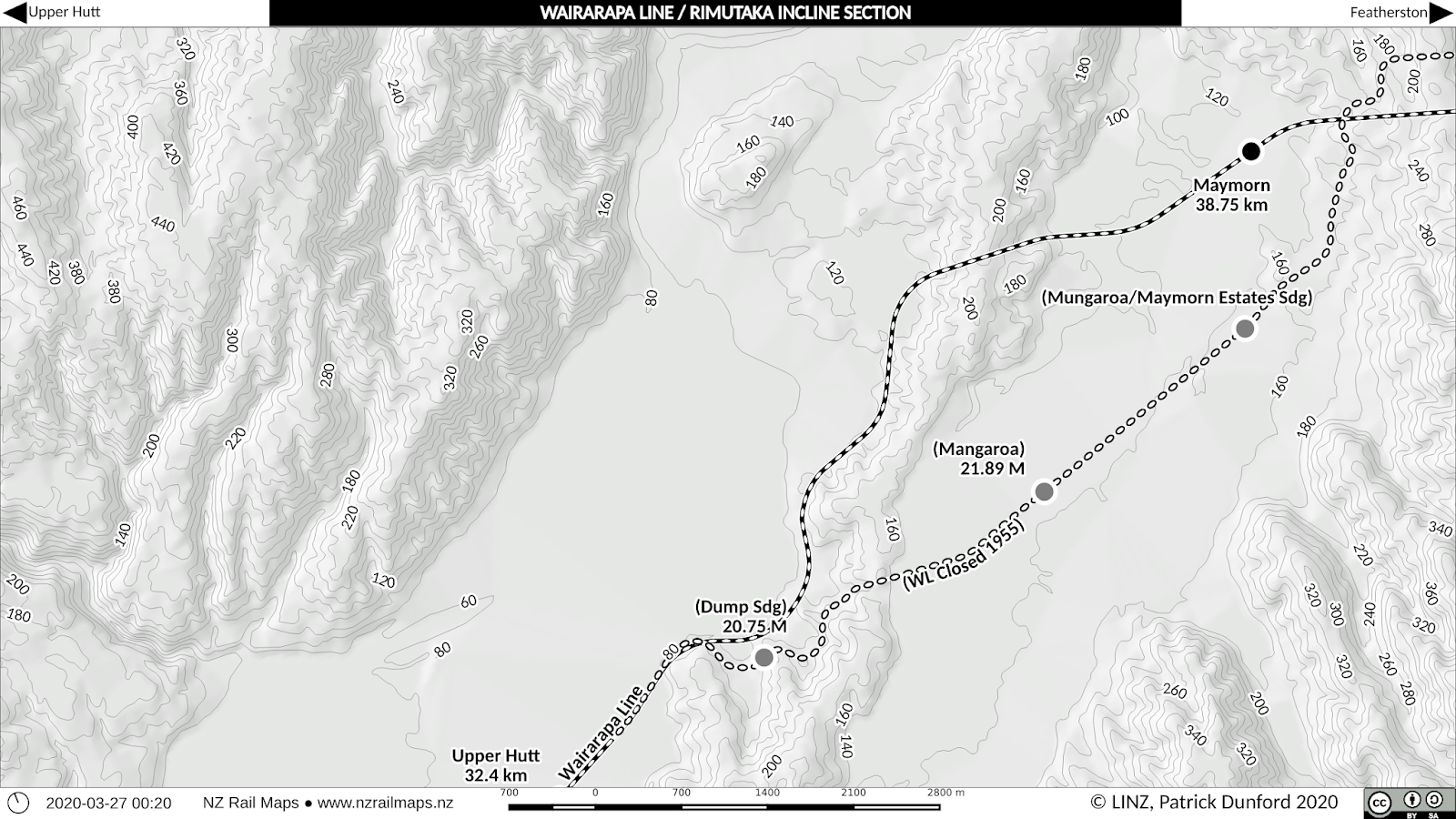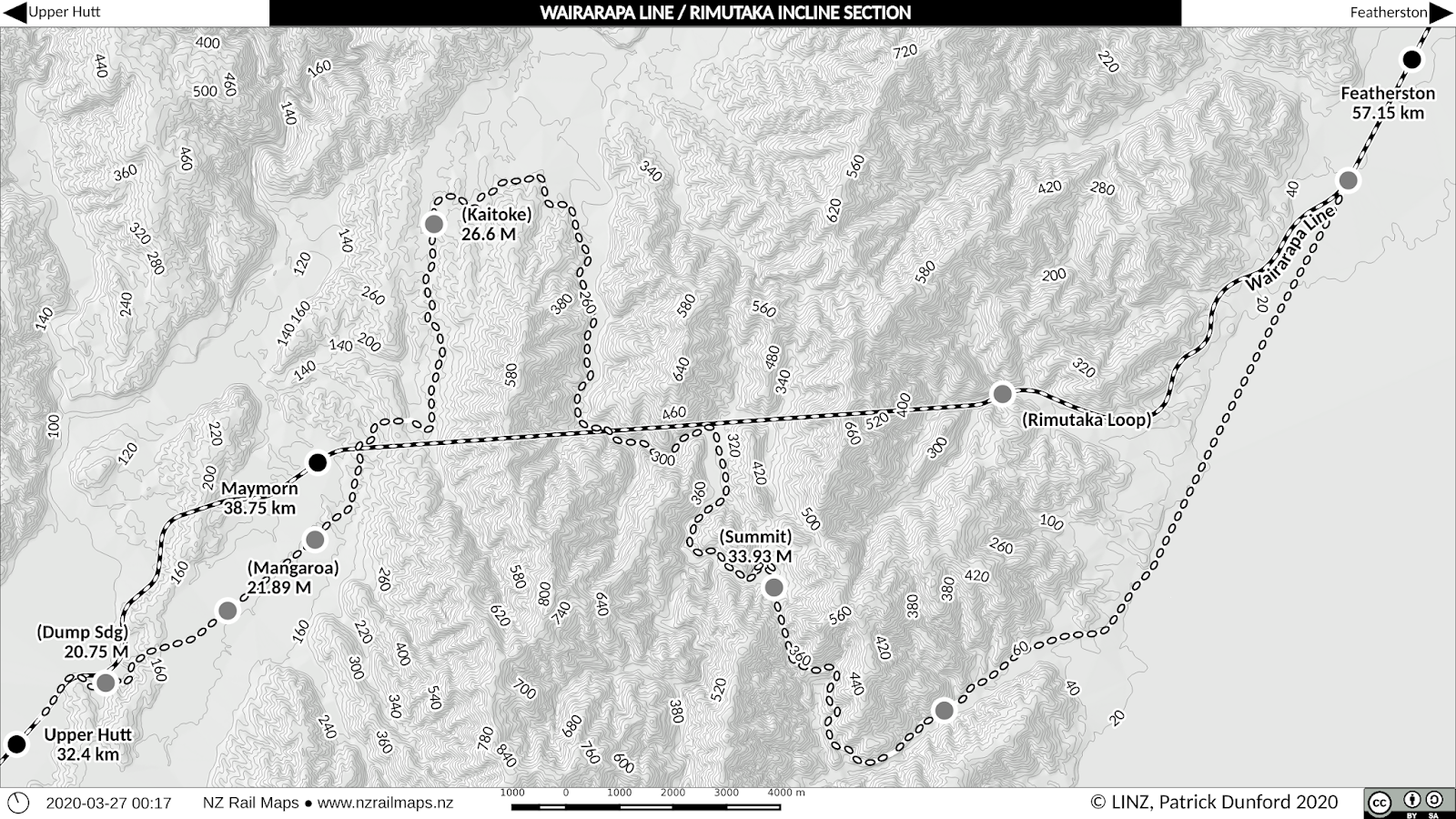So here is the first in a series of 5 articles looking at the "Rimutaka Incline Section", which is an NZ Rail Maps name for the route from Upper Hutt to Featherston via the Rimutaka Incline. In this first pair of articles we are looking at the part from Upper Hutt to the Mangaroa Tunnel, which includes several station sites.
If one visits the Valley Signals site, there are several relevant sections for this area, among them Upper Hutt History, Maymorn Estates and Cruickshanks Tunnel. These are comprised of indepth research undertaken by David Castle over the past 20 years into the general area which incorporates the historical railway that closed 65 years ago. David has supplied additional material not on the site which has been added to maps as well. The full set of production maps for the Rimutaka Incline Section will be published in full when Volume 6 is released but for now you will have to rely on the albums that appear on our Facebook page or group if you want to see the complete set of them.
Depending on which part of the section we are looking at, we have coverage available from 1943, 1951, 1957, 1963, 1970, 1980, 2016 or 2017. Only Google Photos will let you see the original filename of each map, which includes in it the year that the aerial photos were taken. Unfortunately there is no other simple way of indicating this date, since it is impractical to label the map itself with this information. Once we get out of the immediate Upper Hutt residential area the coverage is almost all 1943, 1951 or 1957. with just a little bit from 1980 at Maymorn.


One part of the additional information from Valleysignals is the existence of sidings near the 21 mile peg just north/east of Upper Hutt. These are marked as "refuse dump" and there were two of them as the diagram shows. The aerial photo is from 1943 when the line was still in operation, and the plan from which the information comes is around that date. Note the prominent embankment to the left. Unfortunately this was bulldozed with the recent development of housing in the area. However the rest of the formation is substantially complete and it can be accessed from the end of King Charles Drive to reach the tunnel. The refuse dump siding is shown in the NZRLS 1947 working timetable reprint.


It is not too much further on that the first tunnel is reached (this would be called No.1 Tunnel in the official records, but as many tunnels also had a name, Cruickshanks Tunnel is also well known). The diagram shows a bridge crossing the cutting just west of the tunnel; this was part of the route of a logging tramway for Cruickshanks Sawmill, which was located in Cruickshanks Road in Upper Hutt. The location of that mill appears on the Wairarapa Line maps being adjacent to the present railway rather than the former one. According to Cameron ("A Line Of Railway") a siding was built just "a few chains" north of the tunnel to load timber from the tramway, known as "Cruickshanks" but was lifted in 1889. However, Castle's more recent work published on his VS website does not, as far as I can tell, confirm this in any way. In our previous maps we suggested an approximate location for "Cruickshanks" but being now less certain, we have removed it from the map, and have elected not to draw any possible route for the sawmill tramway at this time. Those who are more interested in this subject may elect to look up the detailed research information on the VS website. There is a whole lot more history than a simple rail history map like this could show but it is still possible we may add the tramway route before publishing the final maps.


For operational purposes the line from Upper Hutt to Mangaroa was split into two parts, divided by the short section of track between No.1 Tunnel and the Mangaroa River bridge. This single diagram and 1943 aerial map show the second part of the section, from the Mangaroa River bridge (far left) to Mangaroa Station (just out of view to the far right) including the second major bridge across what is currently known as Cooleys Stream. The first part of the section, including the tunnel itself, had a continuous gradient of 1 in 35 uphill from Upper Hutt, which is very severe by railway standards and is uncommon on any major route. It was unusual in the case of the Rimutaka Incline Section that this gradient was left in place for such a long time when it could have easily been lowered with a longer tunnel through Cruickshank Saddle.
This meant trains had to be banked over the hill with extra locomotives. As the line was tablet controlled, bank engine key working was provided for. The bank engine on the rear of the train as it left Upper Hutt would carry this key, and would be coupled onto the train all the way up to the bridge. The train would then be stopped for long enough to uncouple the bank engine, which would then run back down to Upper Hutt, whilst the rest of the train continued on the much easier climb to Mangaroa at 1 in 167, which steepened to 1 in 115 on reaching the station. The bank engine key had to be returned to the Upper Hutt stationmaster before the tablet carried on the train engine when it reached Mangaroa could be put back into the machine and any new tablet issued for the section.
Apart from the gradient, the other defining characteristic of the Upper Hutt to Mangaroa Bridge section, was its numerous sharp curves with a radius of about 100 metres. These are also very sharp by mainline standards and limit a train to a maximum speed of only 30 km/h. But because of the gradient, some commentators have suggested a train was unlikely to be moving much faster than 15 km/h when going uphill anyway. In order to ensure the braking system on the train could cope when the train was running south, downhill, in this section, there would be a limit on the size of the train, maybe about 200 tonnes. All these factors together made this part of the railway have a very limited load capacity. But the real defining factor was of course the Rimutaka Incline itself with its 1 in 15 gradient. As long as that was limiting the whole section, there was never any real incentive to make any improvements anywhere else and that's why there was only ever one realignment at Summit when more space was needed for the yard. Then in 1955 the Rimutaka Deviation fixed everything in one go with a completely new route and much easier gradients.
In the last four years of the Rimutaka Incline Section, diesel traction started to be introduced on the NZR, so some trains were worked by DE class locomotives. These were primarily designed for yard and mainline shunting use - that is to say, shunting in yards as well as roving shunts that travel between stations. They did not have multiple unit capability and only had 660 hp engines, so there was still a requirement for double heading with a crew in each cab. In any case, steam was still in use as well, partly because the DEs did not have the braking systems needed for heavy freight trains. The opening of the Rimutaka Deviation was at least dictated by the availability of enough mainline capable diesel locomotives because it was planned that it would never be operated by steam engines. At the date it opened there were just three DG class locomotives in NZ as a whole, and all of them were put into service to run its trains, but these also went from Upper Hutt to Summit on a number of occasions in the last year of the Incline's operation. It was definitely preferred to run diesels on passenger excursions on the Incline section (except for the Incline itself), probably for greater passenger comfort by eliminating smoke nuisance. The regular passenger services since 1936 were mostly handled by the Wairarapa railcars, but very occasionally Standards were used for operational reasons. Many excursion trains were run in the last months of the Incline's operation and there are numerous photos of these trains running with DEs and DGs, as well as DEs hauling the Royal Train of 1953/54. We don't really know how much diesel and how much steam was used without further research but there are plenty of pictures of steam hauled trains on the line in 1955 to know that steam locomotives continued to operate on this section until closure.



These two diagrams and one aerial (from 1943) are of Mangaroa Station. The key feature seen in that era was the RNZAF Stores Base which was in use till the late 1940s, after which it would have been offered to other Government agencies. Some commentators have suggested the Army may have taken up use of the buildings at that time. It appears they are privately owned today. It was served by two railway sidings shown on the second diagram. The first diagram shows the location of the concrete edged loading bank which is the only remaining trace of the station currently. There may have been other tracks in the yard but without obtaining a track diagram from Archives, we are limited to what can be picked up from the aerial photos.
Mangaroa was established in 1885 and was at first called Cruickshanks Siding. It seems to have been the second place on the line that was connected to Cruickshanks timber milling operations and a tramway ran into the station yard at one time. There was also another tramway run by Seeds which ran along Flux Rd and which can be seen in one of the diagrams. This also went into the station yard at one time or another. Seeds operation was to the south of Mangaroa and had a mill in Colletts Road. The name of the station was changed to Mungaroa in 1891 and Mangaroa in 1909. After 1955, the name of Mangaroa was transferred to the new station near the Rimutaka Tunnel, which was then renamed Maymorn in 1959.
Well that's the completion of the first part of these two articles on the first piece of the "Rimutaka Incline Section". As soon as we have the next lot of maps ready we will publish the second part.



















































